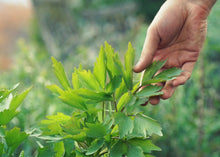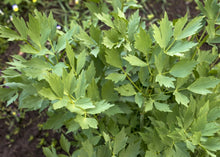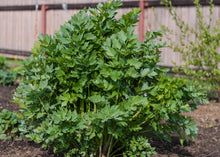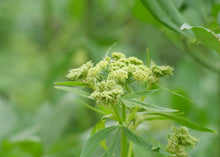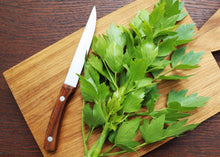
Lovage, affectionately known in our garden as "PERMA CELERY," is a culinary cornerstone for those who want celery flavor without all of the hassle of growing annual celery. This hardy perma veggie thrives year after year, offering a bold and peppery twist on the familiar taste of celery. Its leaves, stems, and seeds serve not just as versatile ingredients in the kitchen, but also boast a variety of health benefits. As a natural diuretic and digestive aid, lovage stands out as a plant that nurtures both our health and our culinary creations. (Levisticum officinale)
We also offer a smaller version of Perma Celery called White Queen Celery Leaf.
Why We Love It
Here are some of the reasons why we love Perma Celery - Lovage:
1) AMAZING TASTE - With its robust and concentrated flavor, a small amount of lovage can significantly enhance a dish. This potent herb delivers a celery-like taste that is both aromatic and savory, making it a powerful addition to soups, stews, and salads.
2) POLLINATOR ATTRACTOR - Lovage is a magnet for beneficial pollinators. Its umbel-shaped flowers offer a feast for bees, butterflies, and other pollinating insects, which are essential for a healthy and thriving garden ecosystem.
3) EASE OF GROWTH - Lovage is a gardener's dream when it comes to low-maintenance cultivation. It's a resilient and hardy plant that adapts well to a variety of climates and soil types, requiring minimal care once established and offering a plentiful harvest year after year.
How to Grow It
Here's how to grow Perma Celery - Lovage:
| SUN | PART SUN IS IDEAL, BUT CAN HANDLE FULL SUN |
| MOISTURE | CONSISTENT MOISTURE WITH GOOD DRAINAGE |
| GROWING ZONES | USDA 3-9 (Not sure? Find your growing zone here) |
| SIZE | 3 FEET TALL & WIDE WITH FLOWER SPIKES UP TO 6 FEET |
| GROWING FROM SEED |
Sow seeds in Spring or Fall. Press seed into soil and keep moist until germination in 1-3 weeks. Plant 2 feet apart. Winter Sowing is the easiest way to start these seeds. Here's a seed-starting tutorial for you. You won't believe how easy it is! PRO TIP: Lovage is known to self-sow generously. To manage its spread, remove any excess seedlings in early summer before they take root or pot up and share with friends. If you'd like to control its growth, make sure to take off the seedheads before they mature and release seeds. |
How to Harvest & Use It
For the best flavor, pick the young leaves of lovage throughout spring and summer. They have a light, sweet taste, like celery with a touch of licorice. Regularly picking the leaves helps the plant to keep producing more. If you notice it stops growing new leaves during the summer, trim back the older leaves. This will give the plant a boost and you'll soon see fresh, new leaves ready to be used in your salads, soups, and stews. Not just the leaves, but the young stems can be cooked, and the seeds are great for baking. You can even eat the roots.






